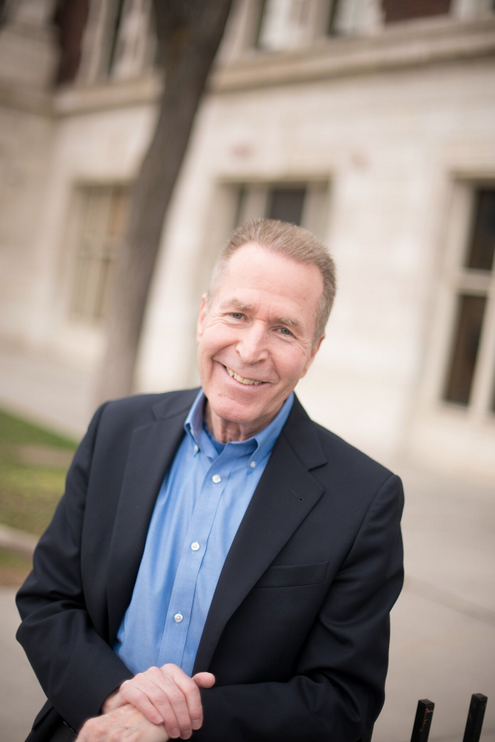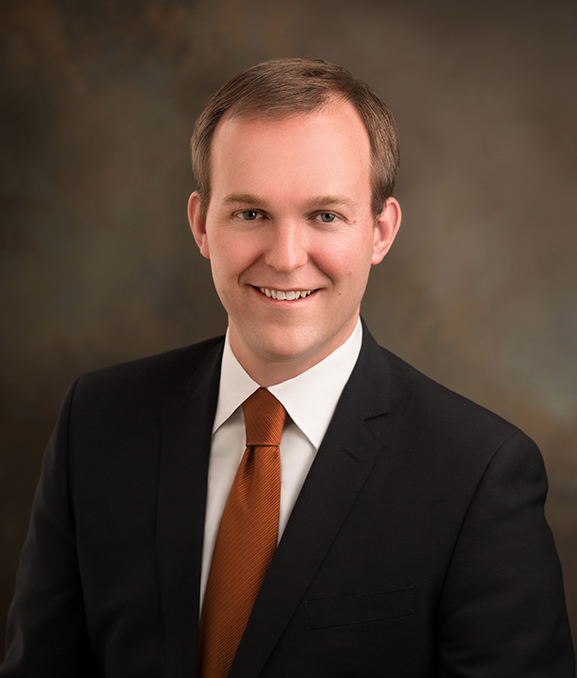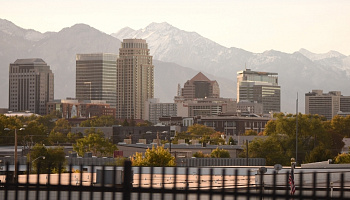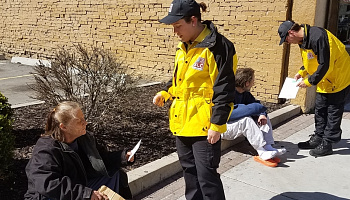In his book Triumph of the City, Harvard Professor Edward Glaeser says “cities don't make people poor; they attract poor people. The flow of less advantaged people into cities demonstrates urban strength, not weakness.”
Downtown is Utah’s center for culture, commerce and entertainment. It is our state’s capital and historic center for finance, law, media and creative enterprise. But at the core of this urban center are the people who make it dynamic and diverse. Downtown plays a role in the lives of many people, including homeless individuals and families, as well as those fighting addiction.
Below are three individuals lending their talents and experience caring and advocating for the community who rely on our downtown for recovery and services.
Celeste Eggert: Advocate & Guardian
When most of us consider what we do and where we go to work, nouns such as “job” or “career” are used. Celeste Eggert instead describes her path as “service” and “calling” in defining her 17 years at the Road Home. Celeste began as a case manager at the agency and has served as Director of Development for the past eleven years.
“It is so difficult to pick a single moment that epitomizes why I love my job,” Celeste states. “I think everytime I see a family or an individual move into housing it reaffirms to me the work we are doing is making a difference. I see people every day that others may think are beyond hope and can't possibly find a way out of homelessness and yet they do. Working at The Road Home reaffirms to me every day that every human being is worthy of a second chance.”
The Road Home is many things to many people, and Celeste describes their role as a stepping stone and a resource for families and individuals who are struggling to find a way out of homelessness. The cliche in marketing materials is true: “we are a hand up, not a hand out.” Clients do the work as they move out of homelessness and back into our community. In fact, 63 percent of the people who come through The Road Home's doors stay for 6 weeks or less.
Celeste sees her role as two-fold: first as an advocate for people experiencing homelessness. “So many people have preconceived ideas of what homelessness is and who the homeless are. Part of my role is an opportunity to educate the public about the work of our agency and this extremely complex issue.” The humanity of The Road Home can be found in looking at the words Celeste uses to describe who they are and what the do. For example, using the word “client” offers a far different image than other words may conjure when thinking of this part of our community’s population. Secondly, as a guardian of our agency's mission, "To help people out of homelessness and back into our community." The Road Home exists because of the generosity of our community. They entrust the staff to serve those experiencing homelessness in the best, most efficient manner possible. “It is a great responsibility and one that we take very seriously.“

Randall Carlisle: One Day at a Time, One Person at a Time.
You may recognize Randall as the face and voice of the evening news, having worked as a reporter and anchor in local television for nearly three decades. Or perhaps you recognize his smile and helpful personality behind the customer service desk at Harmons. A downtown resident for as long as he’s been on the airwaves, what you might not know about Randall is his personal journey as a recovering alcoholic.
Currently sober for three-and-a-half years, Randall generously gives his time and shares his experience towards helping others battling addiction and seeking recovery. The Rio Grande neighborhood is home to numerous 12-step programs, including an AA meeting Randall volunteers to lead bi-weekly.
One of Randall’s motivating factors to become a part of the solution was to begin instilling hope in others. Believing in a “one-day-at-a-time” approach in staying sober,
He also points to his role as a journalist, and being assigned stories about the HOST program as a catalyst to get involved. “I saw what they were doing with this multi-faceted program, and they offered me the space to lead these meetings.” That was six months ago.
Since then, HOST, a collaborative approach between city leaders, SLC Police, the Downtown Alliance and other service providers has helped many people. “The best way we can deal with people is one-on-one, and that includes the HOST program. Whether you help someone out with substance abuse, lack of housing or lack of a job, then you’ve really made a difference in life.” HOST is an acronym for Homeless Outreach Service Team, defined as a proactive and collaborative effort to move the community beyond enforcement of order maintenance issues – public intoxication, disorderly conduct, etc. – to a partnership with homeless service providers that connects homeless individuals with social services and resources.
A firm believer that recovery programs can help, Randall is also quick to point out that “substance abuse and mental illness are top-tier issues” for the individuals who frequent the neighborhood. “Throughout these past six months, I’ve seen people stay clean and sober, find jobs and housing. Unfortunately, that’s in the minority and there are more failures than success stories.”
To understand how to help those suffering from addiction starts with understanding the environment these individuals face each day. The current cluster of services downtown, while convenient from a geographic perspective, also breeds an inhospitable climate for those seeking recovery, as well as for children and families.
When looking towards the future, Randall is incredibly hopeful efforts by Mayor McAdams and Mayor Biskupski to collaborate with state and private funding will change the environment in the Rio Grande neighborhood. Spreading some of the services, even a few blocks will pay great dividends to individuals in the area, as well as surrounding businesses.
Like most public and private leaders, Randal expects downtown to play a continuing role is aiding recovery and minimizing homelessness. “Downtown embraces everyone. There is a friendly climate, regardless of race, gender, sexual identity or walk in life. The homeless population is integral to every downtown around the county, and in my opinion it enhances the experience of living downtown. You can see the diversity. It’s healthy for society.”

Mayor Ben McAdams: Collective Impact
Mayor McAdams is taking serious aim at minimizing homelessness by getting to the root causes, as well as changing the way services are administered in Salt Lake County. The words “Collective Impact” have been used to describe the process and strategy. The nexus of this study and plan began several years ago as problems became more serious in the downtown area, with respect to increasing numbers of homeless individuals and the activities of a criminal element that surrounded them, Salt Lake CIty and Salt Lake County created a two-pronged approach to tackle the issues. Mayor Becker, with the help of volunteer community leaders Palmer DePaulis and Gail Miller, co-chaired a commission to study the current configuration of homeless facilities and emergency shelter. And Mayor Jackie Biskupski kept the momentum moving forward after the 2015 mayoral campaign, identifying homelessness as one of her key priorities. Meanwhile, Mayor Ben McAdams co-chaired a committee with all the homeless service providers to map out the system of homeless services. After completing a year of meetings and public outreach, both groups reached a consensus to adopt the collective impact outcomes and agreed on the common agenda to minimize homelessness.
After bringing key stakeholders together from both the homeless facilities operations and service provider worlds, Mayor McAdams asked the group to dive deeply into the current homelessness system. He calls it “mapping the genome” of homelessness services, and tallied $52 million annually in government and private funds for homeless specific services. The true figure is actually higher, as this did not account for associated costs such as jail, hospital and emergency first responder expenses. “Homelessness data collected by the state showed that people are cycling through multiple, uncoordinated systems,” said McAdams. “Everyone was trying hard and everyone was doing good work. But too often the impact was isolated and temporary. By bringing everyone together and agreeing to work on a common agenda, with specific outcomes and measurable indicators, we can harness that dedicated effort around a shared solution – minimizing homelessness.”
The Collective Impact Steering Committee identified system-wide challenges. It defined 14 specific outcomes for individuals and families experiencing homelessness, preventing homelessness and housing and service systems. The outcomes are determined by a set of clear, defined and measurable indicators. Using data collected by the State of Utah over the past decade, they are able to benchmark where we are now and track the results of our actions and expenditures that are designed to help the different and distinct groups of homeless individuals, such as families with children, veterans, and the working homeless.
Cities across the nation including Salt Lake City, are struggling to address the issue of homelessness. Each of the three leaders we spoke to offer their opinions on where to be mindful and direct our attention and efforts. Randall is quick to point to a “necessary increase in inpatient treatment facilities,” to aim at the root causes of addiction. Mayor McAdams reminds us that “the notion of a ‘one-size-fits-all’ approach for emergency shelter and programs ignores the complicated and diverse causes of and risks for homelessness.” Celeste sees housing as the answer: “Downtown Salt Lake City has an opportunity to attend to this issue through the creation of more affordable housing. By creating more deeply affordable housing opportunities in Salt Lake City and across our state, we can help to reduce the need for people to turn to shelters in the first place.“





